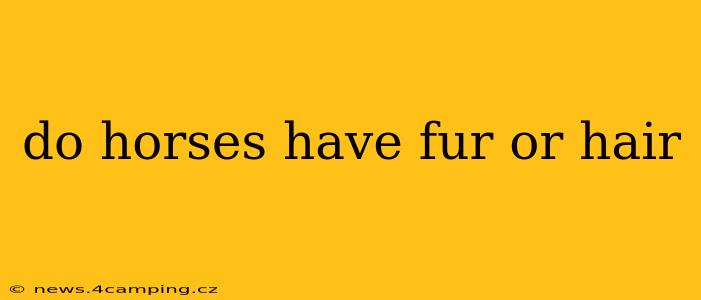The question of whether horses have fur or hair is a surprisingly common one, and the answer isn't as simple as a yes or no. While the terms are often used interchangeably in everyday conversation, there are subtle biological differences that help clarify the distinction. The short answer is: horses have hair, not fur.
Let's delve deeper into the specifics to understand why.
What's the Difference Between Fur and Hair?
The key difference lies in the structure and function of the hair fibers. Fur, typically found on mammals adapted to colder climates, is characterized by:
- Dense undercoat: A soft, insulating layer close to the skin that traps warm air.
- Guard hairs: Longer, coarser hairs that protect the undercoat from the elements and provide camouflage.
- Seasonal shedding: A significant molt of both undercoat and guard hairs to adapt to changing temperatures.
While horses do experience seasonal shedding, their coats lack the dense undercoat characteristic of fur. Instead, their coats are primarily composed of:
- Guard hairs: These hairs make up the majority of a horse's coat, providing protection from sun, wind, and rain.
- A thinner undercoat (in some breeds): Some horse breeds have a finer, less dense undercoat compared to animals with fur. This undercoat is usually shed in the warmer months.
Do Horses Shed Their Coats?
Yes, horses shed their coats seasonally. This shedding process is influenced by factors like breed, climate, and nutrition. Horses in colder climates will grow thicker coats in the winter and shed them in the spring and summer. The shedding process helps horses regulate their body temperature and maintain comfort throughout the year. This shedding process, though substantial, differs from the dramatic molt seen in animals with fur.
What Type of Hair Do Horses Have?
Horses' hair is structurally similar to human hair, but with some key differences in thickness, texture, and pigmentation. They possess various types of hair, including:
- Long hairs: These cover most of the body and provide significant protection.
- Short hairs: Often found on the face and legs, these hairs offer less insulation but help regulate temperature in these areas.
- Mane and tail hairs: These specialized hairs are longer and stronger than other body hair, providing additional protection and sometimes even aiding in communication or defense.
Why the Confusion Between Fur and Hair in Horses?
The confusion arises largely from the common usage of the terms. In everyday language, "fur" is often used generally to describe the hairy coat of animals. However, scientifically, the distinction based on the density and structure of the coat is important. The term "hair" more accurately reflects the composition of a horse's coat.
What About Different Horse Breeds?
Different horse breeds have variations in their coat density and thickness due to genetics and adaptation to different environments. Some breeds, such as those originating from colder climates, have slightly denser coats than those from warmer regions. However, even in the thickest-coated breeds, the structure remains primarily guard hairs with a less dense undercoat compared to animals with true fur.
In summary, while the terms are often used interchangeably, horses possess hair, not fur. The characteristics of their coats, including seasonal shedding and the relative lack of a dense undercoat, differentiate them from animals possessing true fur.
